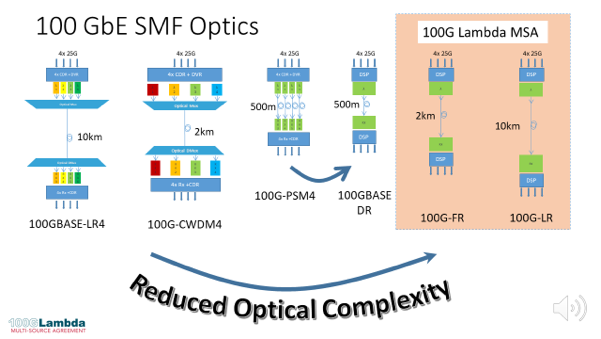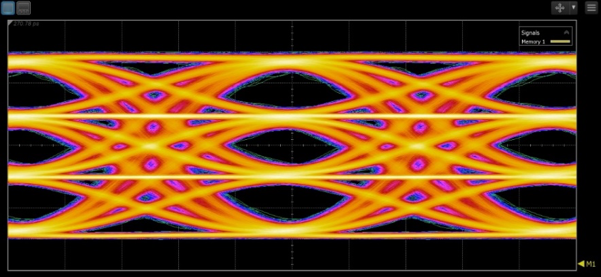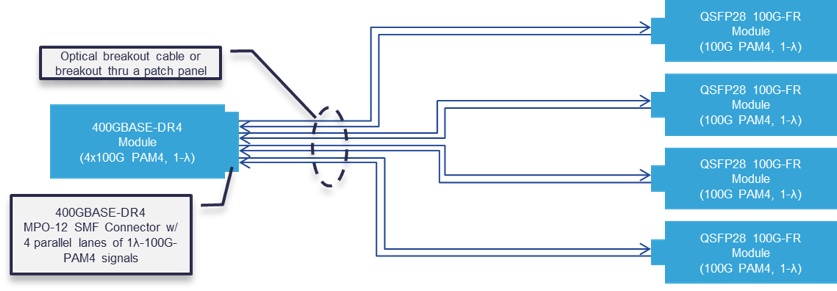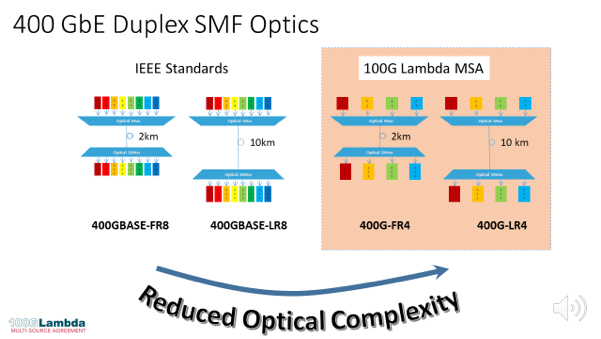































 Ray Nering, Product Manager, Transceiver Modules Group, Cisco
Ray Nering, Product Manager, Transceiver Modules Group, CiscoOn Sept 20, 2018, the 100G Lambda MSA group announced that membership to the MSA has increased from the original 22 promoters, to include an additional 16 contributors. The MSA has been developing 100G and 400G optical specifications that leverage 100G on a single wavelength to drive down cost. As vendors begin to realize the advantage and growing momentum in the market for 100G per lambda solutions, companies are joining the MSA.
Also, the MSA announced the release of draft 2.0 of the specifications targeting data center and service provider applications for duplex single mode fiber links. The MSA specifications reduce the optical component complexity required to transmit 100GE and 400GE.
The three dominant standards for 100GE deployed in networks today are the IEEE's 100GBASE-LR4, CWDM4 MSA and PSM4 MSA. All three are fairly complex from an optical component standpoint to aggregate 25G signals to 100G link. Today, 100GE traffic is typically deployed in networks with QSFP28 modules, which utilize a 4x 25Gb/s electrical interface with host ports. That interface makes it very convenient to directly drive 4 wavelengths multiplexed together on to a single fiber.
In the early days of 100G technology, the IEEE designed the 100GBASE-LR4 specification to support 10km links, and they decided at the time to use LAN-WDM wavelength spacing. That requires controlling the laser wavelength very tightly because they are spaced closely together. This is shown graphically in Figure 1. Generally this is accomplished by controlling the laser temperature and requires costly hermetic packaging.
 Figure 1: 100G SMF Standards
Figure 1: 100G SMF Standards
Later the CWDM4 MSA group came up with a variation to reduce costs. They specified the laser wavelengths to have a much wider window or tolerance and spaced them far apart. This didn't require the costly packaging that 100GBASE-LR4 does, but they limited the reach to 2km.
Then came the 100G PSM4 MSA group. Their approach was to use 4 pairs of fibers and open up the specification for just one laser wavelength window to be very wide. This approach eliminated the complexity of multiple wavelength lasers, multiplexing and de-multiplexing wavelengths but it added complexity of four pairs of fibers to the module and to the interconnecting cable infrastructure, instead of just one pair for LR4 or CWDM4.
As CMOS technology has evolved to smaller geometries enabling higher speed, higher density and higher efficiency, complex signal processing can now be moved inside the pluggable optical modules. The IEEE recognized this and came up with a standard called 100GBASE-DR. This approach takes the 4x 25G electrical signal from the host and uses a DSP to translate that to a PAM-4 signal (Figure 2) instead of using NRZ signals as is done with LR4, CWDM4 or PSM4. That signal can then be used on a single wavelength that can accommodate wide tolerances and not require a costly series of optical components and packaging.
The IEEE specified 100GBASE-DR for 500m links. 500m applications are limited to very short links and accommodates the insertion loss of a limited number of patch panels. The 100G Lambda MSA extended the reach to 2km with 100G-FR. This allows the module to be used not just for longer links, but also for infrastructure that may include a higher number of patch panels or just higher loss environments. The MSA also extended the reach again to 10km with 100G-LR, addressing the same applications as 100GBASE-LR4.
 Figure 2: PAM-4 Signal
Figure 2: PAM-4 Signal
Not only do these new 100G standards reduce the complexity of the optical components inside these modules, reducing the cost of 100GE links, but they also enable the bridge between 100G and the migration to 400G. The IEEE leveraged 100GBASE-DR for the 400GBASE-DR4 optical standard. The 400GBASE-DR4 is essentially four parallel 100GBASE-DR in a single module providing 400G connectivity over 500m. This approach also enables 100G breakouts from a 400G port as shown in Figure 3. At this point in time there is no way to accomplish this type of breakout with any other 100G module. With CWMD4 or LR4 there is no compatible 400G module that can provide this feature. Operating in breakout, 400GBASE-DR4 effectively provides the industry's highest density 100G module, four 100G modules in the space of a QSFP-DD form factor.
It is expected that some manufacturers will also produce 4x 100G-FR modules that provide the ability to extend the reach of 100G breakouts beyond 500m reach limitations of 100GBASE-DR. The MSA has carefully chosen the requirements for 100G-FR to be 100% compatible with 100GBASE-DR for maximum flexibility to end users.
 Figure 3: 400GBAS-DR4 Breakout to 100G-FR
Figure 3: 400GBAS-DR4 Breakout to 100G-FR
The 100G Lambda MSA group also looked at the existing IEEE 400G standards. For duplex transmission, the IEEE came up with 400GBASE-FR8 for 2km and 400GBASE-LR8. These standards rely on 8 lanes of 50G PAM-4 optical signals on the LAN-WDM wavelength grid, the same as 100GBASE-LR4. These standards will have the same issues as 100GBASE-LR4, tight wavelength windows spaced close together, requiring tight wavelength control and usually driving higher cost packaging. The number of wavelength channels required along with the number of transmitters and receivers and the complexity of the multiplexer and de-multiplexer seem costly. The MSA decided that using the 100G per wavelength instead of 50G (same approach as 100G-FR/LR) and using four channels on the CWDM wavelength grid with wider window of tolerance provide a lower cost path for 400G. The MSA developed the 400G-FR4 specification for duplex single mode fiber applications with up to 2km reach.
 Figure 4: 400G Standards
Figure 4: 400G Standards
The 100G Lambda MSA has released three updated drafts of their specifications (2.0) for 100G-FR, 100G-LR and 400G-FR4. There is still more work to be done with 400G-LR4. In the meantime, vendors are developing modules with the new standards. I would expect to products released to the market over the next 12 months. Ready or not here comes 400G!
 Tags chauds:
#CiscoOptics
#CiscoOpticsBlog
Cisco Optical Networking
Cisco optics
100G
400G
#SingleLambda100G
CWDM4
100G Lambda
Tags chauds:
#CiscoOptics
#CiscoOpticsBlog
Cisco Optical Networking
Cisco optics
100G
400G
#SingleLambda100G
CWDM4
100G Lambda